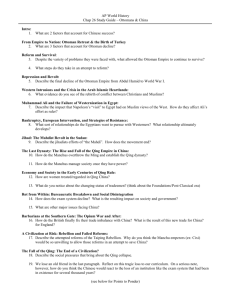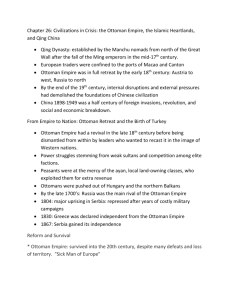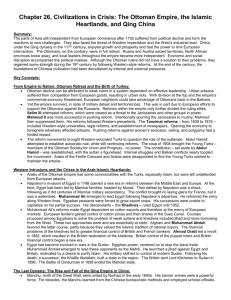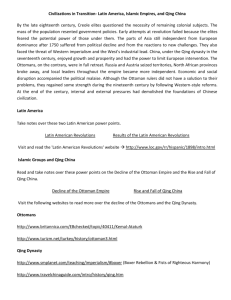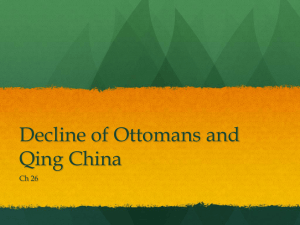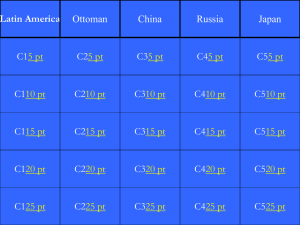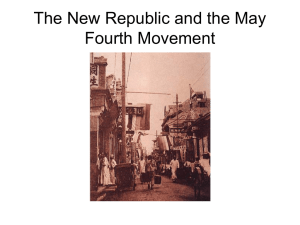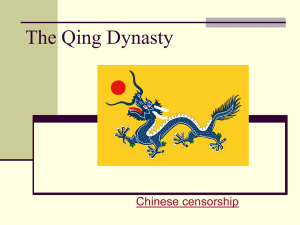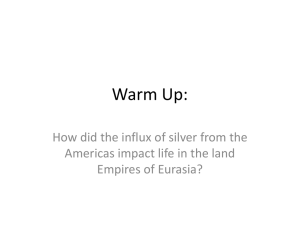Chapter 26 Civilizations in Crisis: The Ottoman Empire, the Islamic
advertisement
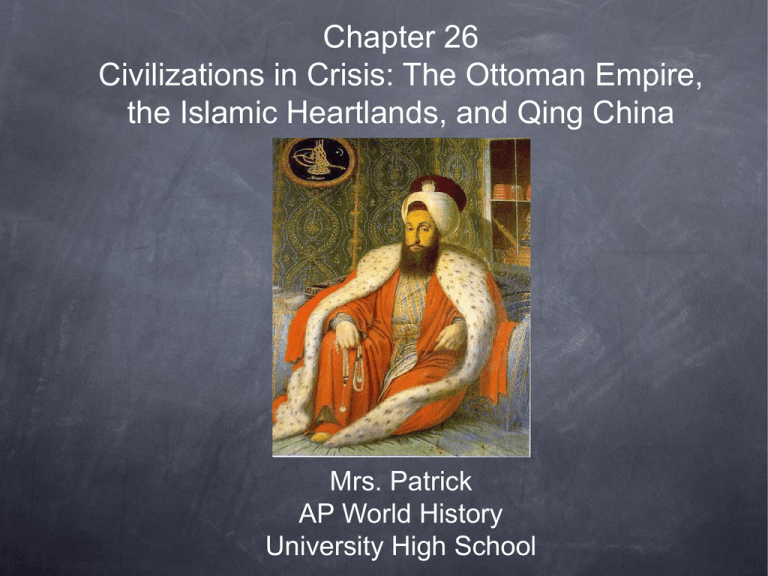
Chapter 26 Civilizations in Crisis: The Ottoman Empire, the Islamic Heartlands, and Qing China Mrs. Patrick AP World History University High School From Empire to Nation: Ottoman Retreat and the Birth of Turkey The Ottoman crisis was brought on by a succession of weak rulers within a poorly constructed political and social order. Artisan workers saw the deterioration of Turkish goods because of the influx of Western manufactured goods. Internal fighting led to loss of territory. In the late 1700‘s, the Russian empire became the main threat to the Ottoman empire. By 1870’s, Ottomans were driven from the Balkans. From Empire to Nation: Ottoman Retreat and the Birth of Turkey The Ottomans survived because of divisions between European nations. The British supported the Ottomans to prevent the Russians from controlling Istanbul. Sultan Selim III attempted reforms at improving administrative efficiency. Sultan Mahmud II overthrew the Jannissaries with a secret army. Tanzimat Reforms (1839-1876) introduced Western influences throughout the empire. From Empire to Nation: Ottoman Retreat and the Birth of Turkey Western educated bureaucrats, military officers and professionals threatened the power of the sultans. Sultan Abdul Hamid nullified the constitution and restricted civil liberties. The military continued westernization. Ottoman Society for Union and Progress (1889) led a coup to overthrow Abdul Hamid. Sultan was retained as a political figurehead and authority on religion only. Western Intrusions and the Crisis in the Arab Islamic Heartlands Napoleon invaded Egypt in 1789, hoping to later destroy British power in India. Napoleon dealt the Mamluks (living in Egypt) a crushing defeat. The British cut off supply lines from the French and Napoleon was forced to end the conquest of Egypt. This showed a weakness in Islamic allies for not defending this territory. Western Intrusions and the Crisis in the Arab Islamic Heartlands After the French withdrawal, Muhammad Ali (not Cassius Clay) emerged as the leader of Egypt. Muhammad Ali updated the Egyptian military a Western-style military. He invaded Syria, built a war fleet and threatened Istanbul on a few occasions. He also tried many reforms that did not work. After he died, his successors did not pursue expansion. Western Intrusions and the Crisis in the Arab Islamic Heartlands Cotton expansion in Egypt made it dependent on a single export. Suez Canal (completed in 1869) connected the Mediterranean Sea to the Red Sea. Its completion made Egypt one of the most strategic places on Earth. It made easier commercial and military links to Europe and its colonies in Asia and east Africa. Western Intrusions and the Crisis in the Arab Islamic Heartlands Many Muslim scholars and intellectuals met and discussed how to ward off the growing power of Europe. Many Muslim scholars and intellectuals discussed the need to borrow learning and technology from the West. There was a need for Muslim unity to face the growing European threat. Many Egyptians supported Ahmad Orabi and led a revolt against the Egyptian rulers. The British (who had an interest in the canal) crushed Orabi’s rebellion. Western Intrusions and the Crisis in the Arab Islamic Heartlands Egypt tried to conquer and rule the Sudan and centered Egyptian administration in Khartoum. Egyptians were resented by the peoples in Sudan. Muhammad Achmad became a leader to unite the Sudanese to fight back. Muhammad Achmad proclaimed a jihad against the Egyptians and British and it was one of the most violent Islamic responses in history. Within a few years, this Mahdist Revolt controlled present day Sudan. Western Intrusions and the Crisis in the Arab Islamic Heartlands Khalifa Abdallahi took over after Muhammad Achmad died. The Mahdists built a strong, expansive state. Their society was very closely controlled. British General Kitchener was sent to end the Mahdist threat. The Mahdist power ended within a year. The Last Dynasty: The Rise and Fall of the Qing Empire in China Manchu nomads had been living north of the Great Wall for decades. Nurhaci unified many of the Manchu tribes. In the declining Ming dynasty, the Manchus were able to seize power in China. Manchus were used to suppress a rebellion in China, but instead, seized the capital of Beijing (1644). The Manchus take the dynastic name “Qing”. The Qing maintained much of the political systems of the Ming. The Last Dynasty: The Rise and Fall of the Qing Empire in China The Qing kept much of the conservative politics in China. Women remained confined to the household. Men dominated society. Qing rulers aimed to alleviate rural distress by lowering tax and labor demands. The gap between landowning and peasant classes grew larger. Commercial and urbanization expanded. The Last Dynasty: The Rise and Fall of the Qing Empire in China The bureaucracy began to deteriorate overtime and led to the decline of the Qing. Bribery and cheating on civil service exams was rampant and common. Revenue continued to decline and public works projects were not completed. In the 1860’s, the Yellow River flooded the Shandong peninsula and thousands of peasants died of famine and disease. Food shortages and landlord demands prompted mass migrations. The Last Dynasty: The Rise and Fall of the Qing Empire in China The Chinese and British were hostile because of trade agreements. The British ended up trading opium from India to the Chinese. Qing emperors issued edicts forbidding opium trafficking. Lin Zexu (an official) ordered European trade blocked, the opium to be confiscated and destroyed. War broke out in 1839 and the Chinese were defeated. This led to Europeans forcing the Chinese to open trade and diplomatic exchanges. The Last Dynasty: The Rise and Fall of the Qing Empire in China Taiping Rebellion (1850-1865) Led by Hong Xiuquan Established the Taiping Heavenly Kingdom (an opposition force to the Qing) with its capital in Nanjing The Taiping proposed alternatives to the Qing dynasty. The Qing and the scholar-gentry were able to raise armies that eventually defeated the Taiping. An estimated 25 million people died. The Last Dynasty: The Rise and Fall of the Qing Empire in China Manchu leaders repeatedly resisted reforms in China. Empress Cixi crushed movements of reform. She had her nephew, the emperor, imprisoned. The Boxer Rebellion was an anti-imperial, anti-Christian movement (1898-1901). The Last Dynasty: The Rise and Fall of the Qing Empire in China Underground secret societies inspired numerous uprisings against the dynasty. Resistance was also seen from young men who received Western educations. The revolution of 1911 toppled the Qing dynasty. In 1912, the last emperor of China (Puyi) was deposed and the republican government of China was established. Chapter 26 Discussion Questions How was it possible that the Ottoman Empire survived for as long as it did? In what aspects of Ottoman society were Western ideas and technology seen? How did the French invasion of Egypt show vulnerability in Muslim lands? Describe the two arguments by Muslim intellectuals and scholars for how to deal with the growing threat of Europe. Explain how the Qing dynasty followed the typical cyclical pattern of Chinese dynasties. How did the Opium War swing the balance of trading power from China to Europe?
